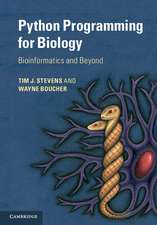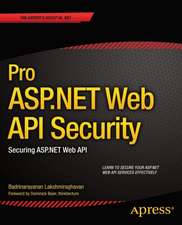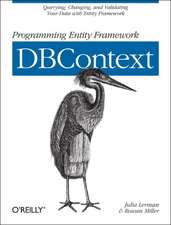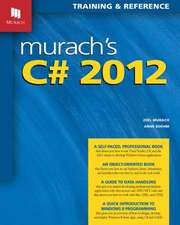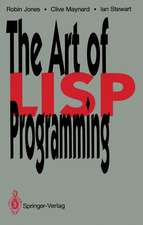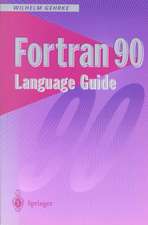The F Language Guide
Autor Wilhelm Gehrkeen Limba Engleză Paperback – 30 mai 1997
Preț: 337.85 lei
Preț vechi: 422.31 lei
-20% Nou
Puncte Express: 507
Preț estimativ în valută:
64.65€ • 70.21$ • 54.31£
64.65€ • 70.21$ • 54.31£
Carte tipărită la comandă
Livrare economică 22 aprilie-06 mai
Preluare comenzi: 021 569.72.76
Specificații
ISBN-13: 9783540761655
ISBN-10: 3540761659
Pagini: 352
Ilustrații: XV, 334 p.
Dimensiuni: 155 x 235 x 18 mm
Greutate: 0.57 kg
Ediția:Softcover reprint of the original 1st ed. 1997
Editura: SPRINGER LONDON
Colecția Springer
Locul publicării:London, United Kingdom
ISBN-10: 3540761659
Pagini: 352
Ilustrații: XV, 334 p.
Dimensiuni: 155 x 235 x 18 mm
Greutate: 0.57 kg
Ediția:Softcover reprint of the original 1st ed. 1997
Editura: SPRINGER LONDON
Colecția Springer
Locul publicării:London, United Kingdom
Public țintă
Professional/practitionerCuprins
1 Source Form.- 1.1 Classification of F Statements.- 1.2 Statement Ordering.- 2 Type Concept.- 2.1 Intrinsic Types.- 2.2 Derived Types.- 3 Lexical Tokens.- 3.1 Scoping Units.- 3.2 Keywords.- 3.3 Names.- 3.4 Operators and Assignment Symbol.- 3.5 Literal Constants.- 4 Data Objects.- 4.1 Constants.- 4.2 Variables.- 4.3 Scalars.- 4.4 Arrays.- 4.5 Structure Components.- 4.6 Automatic Variables.- 4.7 Association.- 4.8 Definition Status.- 5 Pointers.- 5.1 Pointer Concept.- 5.2 Pointer Processing.- 6 Array Processing.- 6.1 Array Declaration.- 6.2 Reference and Use.- 6.3 Memory Management and Dynamic Control.- 6.4 Array Constructor.- 6.5 Operations on Arrays.- 7 Expressions.- 7.1 Numeric Intrinsic Expressions.- 7.2 Relational Intrinsic Expressions.- 7.3 Logical Intrinsic Expressions.- 7.4 Character Intrinsic Expressions.- 7.5 Defined Expressions.- 7.6 Common Rules for Expressions.- 7.7 Special Expressions.- 8 Assignments.- 8.1 Intrinsic Assignment Statements.- 8.2 Defined Assignment Statements.- 8.3 Pointer Assignment Statement.- 8.4 Masked Array Assignments.- 9 Declarations and Specifications.- 9.1 Attributes.- 9.2 Type Declaration Statements.- 9.3 Additional Specification Statements.- 10 Execution Control.- 10.1 IF Construct.- 10.2 CASE Construct.- 10.3 DO Construct.- 10.4 Nested Constructs.- 10.5 STOP Statement.- 11 Input/Output.- 11.1 Records.- 11.2 Files.- 11.3 File Attributes of External Files.- 11.4 Units.- 11.5 Preconnected Units and Predefined Files.- 11.6 Input/Output Statements.- 12 Formats.- 12.1 Format Specification.- 12.2 Interaction between Input/Output List and Format.- 12.3 Edit Descriptors.- 13 Program Units and Subprograms.- 13.1 Main Program.- 13.2 Modules.- 13.3 Subprograms.- 13.4 Internal Program Communication.- 14 Intrinsic Subprograms.- 14.1 Intrinsic Functions.- 14.2 Intrinsic Subroutines.- 14.3 Intrinsic Subprogram Reference.- 14.4 Intrinsic Subprogram Definitions.- Appendices.- A ASCII Character Set and Collating Sequence.- B Models for Numbers.- B.1 Models for Integers.- B.2 Models for Reals.- B.3 Models for Bit Manipulation.- C Program Example.- D F versus Fortran 90.- E F Language Syntax Charts.- E.1 Notation Used in this Syntax.- E.2 F Terms and Concepts.- E.3 Characters, Lexical Tokens, and source Form.- E.4 Intrinsic and Derived Data Types.- E.5 Data Object Declarations and Specifications.- E.6 Use of Data Objects.- E.7 Expressions and Assignment.- E.8 Execution Control.- E.9 Input/Output Statements.- E.10 Input/Output Edting.- E.11 Program Units.- E.12 Procedures.- F Index.


